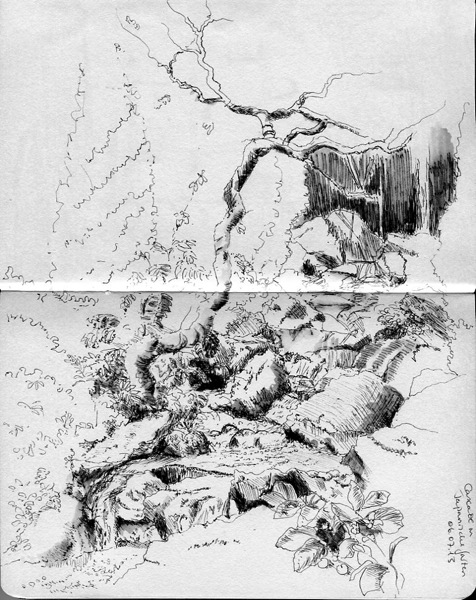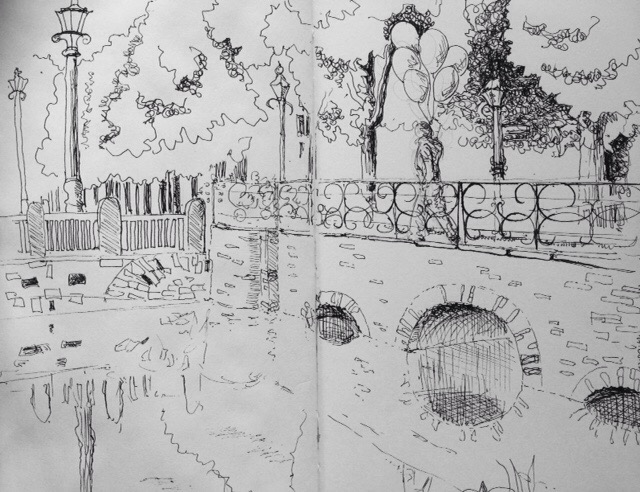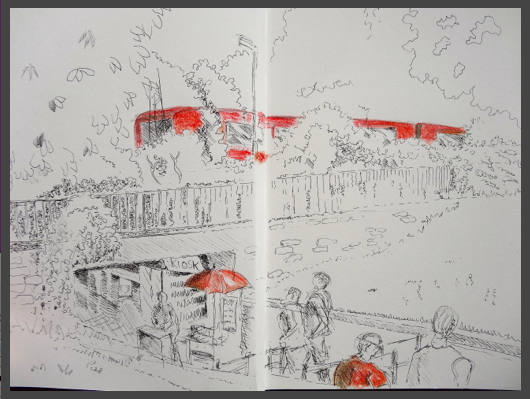For the past few weeks, I have been dealing with the practicalities of moving as well as those of the end of the school year, which is always more hectic than it ought to be. Sketching has been relegated to odd moments. This post is a hotch-potch of sketches made during this period. Unless otherwise stated, the drawings were made in an A5 Hahnemühle sketchbook.
Firstly, here are sketches made during two Reiseskizzenbuch evening classes. The first drawings were made in the Bachstraße, behind the Landesmuseum in Bonn. This quiet tree-lined street in Bonn’s Weststadt has diverse architecture. Many of the houses bear elaborate carvings typical of those built during the Gründerzeit, the mid to late 19th century. Houses built during this period often reflected the wealth and social standing of their owners through the use of neo-classical and neo-renaissance design and are sought after today.
For me personally, the most interesting aspects of these houses are to be found in their upper storeys and it was on these that I focused. The first drawing was made in pencil (2H, HB and 2B). I aimed to vary the detail in the drawing so that the carved pillar / statue nearer the viewer appears to be more in focus than the one on the right, which is further away; however, the further one needs a little more modelling as it appears too flat in the face. I did not spend enough time planning this drawing, which is not properly situated on the page and yet, perhaps, its asymmetricality gives it a certain energy.

For the second drawing, I used Derwent Graphitint pencils, unused for a while, plus a selective wash. My eye was taken by the little angel in the centre, looking protectively down on the house. The spatter is due to rain the following week!

The following Thursday, we drew in the area just to the north of the Bonner Münster. It was freezing cold and drizzled for much of the time so we seated ourselves underneath the awning of a clothes store.
The first drawing is of the massive sculpted heads of Cassius and Florentius which lie on the paving at the eastern end of the Münsterplatz. This was drawn with a fineliner. The drawing was not completed due to the onset of rain (some spatter evident) but maybe works better for having the further head in outline only, providing a foreground focus.

While it drizzled, we sat under an awning and continued to draw. The next drawing puts the heads of the two martyrs in context and conveys a better sense of their size. Bonn has a history stretching back 2,000 years to Roman times. According to legend, Cassius and Florentius were legionnaires who executed for refusing to worship pagan gods. Their remains are now in the crypt of the Münster. The drawing was made with HB pencil, Graphitint pencils and wash. I added fineliner to give more definition to the image. The view is of the exterior walls to the Münster gardens which are not, as far as I know, open to the public. The figure in front of the tree was standing with his briefcase on the ground and is not, in fact, kneeling as he appears to be… The image is rather drab, reflecting my feelings about the weather. It would be interesting to do a series of drawings of a scene under different weather / lighting conditions to see the variation, which I suspect would be due as much to personal response to the weather as to the lighting conditions themselves. This drawing definitely reflects that it was made on a dull, cold, wet evening…

Because the drawings above were made rather quickly, I wanted to spend more time on a single drawing and pay attention to detail. The following week, I drew another fineliner drawing over a least an hour. This sketchbook is almost finished and the pages no longer lie flat, hence the dark shadow in the centre of the scanned image. The weather was very different – warm and sunny – and the city was full of people sitting out enjoying the summer evening. This city gate – the Sterntor – looks authentic but is not the original, which dated from the 13th century but was torn down at the end of the nineteenth century. It was rebuilt shortly afterwards from a mish-mash of original bits of old wall and tower.
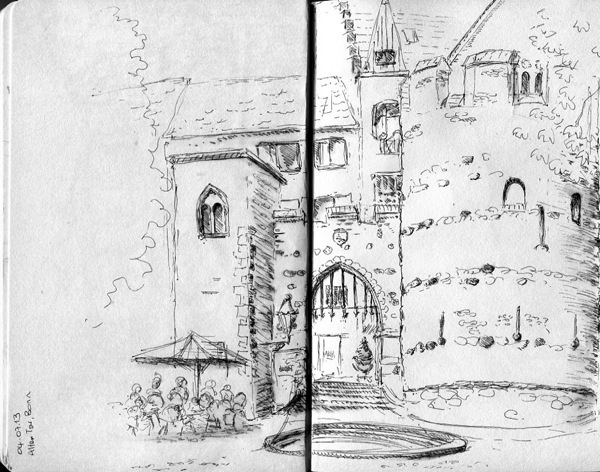
Here are two drawings made during the days immediately after my recent move when I was still surrounded by cardboard boxes… The first drawing is made with a Graphitint pencils and the second with a black gel pen. Both drawings were made in a square format sketchbook but have been scanned which has altered the format. I had difficulty in getting the correct angle for the open door which is situated along a wall that cuts off a corner of the living room. This provides a great view of the gardens and fields beyond but is a challenge to draw. I have tried to use the light and shade falling on the boxes to convey a sense of their mass.
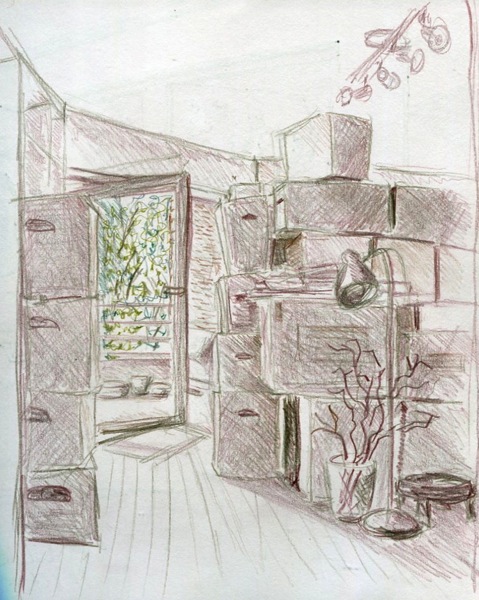

Finally, I have been trying too get a drawing group off the ground over the past months. That I have not been very successful is entirely due to my lack of skill and dedication in organising events. However, last weekend two of us did meet up and draw in the Japanese Garden in the Bonner Rheinaue. While drawing, an event in the park organised by the local Filipino community provided home-grown music to accompany us as we drew in the sun.
Again, I decided to take time with a single drawing using a fineliner. This drawing is of the cascade in the garden. Drawing water is always difficult. I have tried to capture it by drawing everything around the water and hoping that the water would suggest itself as negative space. This works to an extent at the front of the cascade but gets lost further away where the water lies in the shade. I omitted the foliage on the central tree in order to use the shapes created by the branches and not to add extra “fuss”.
